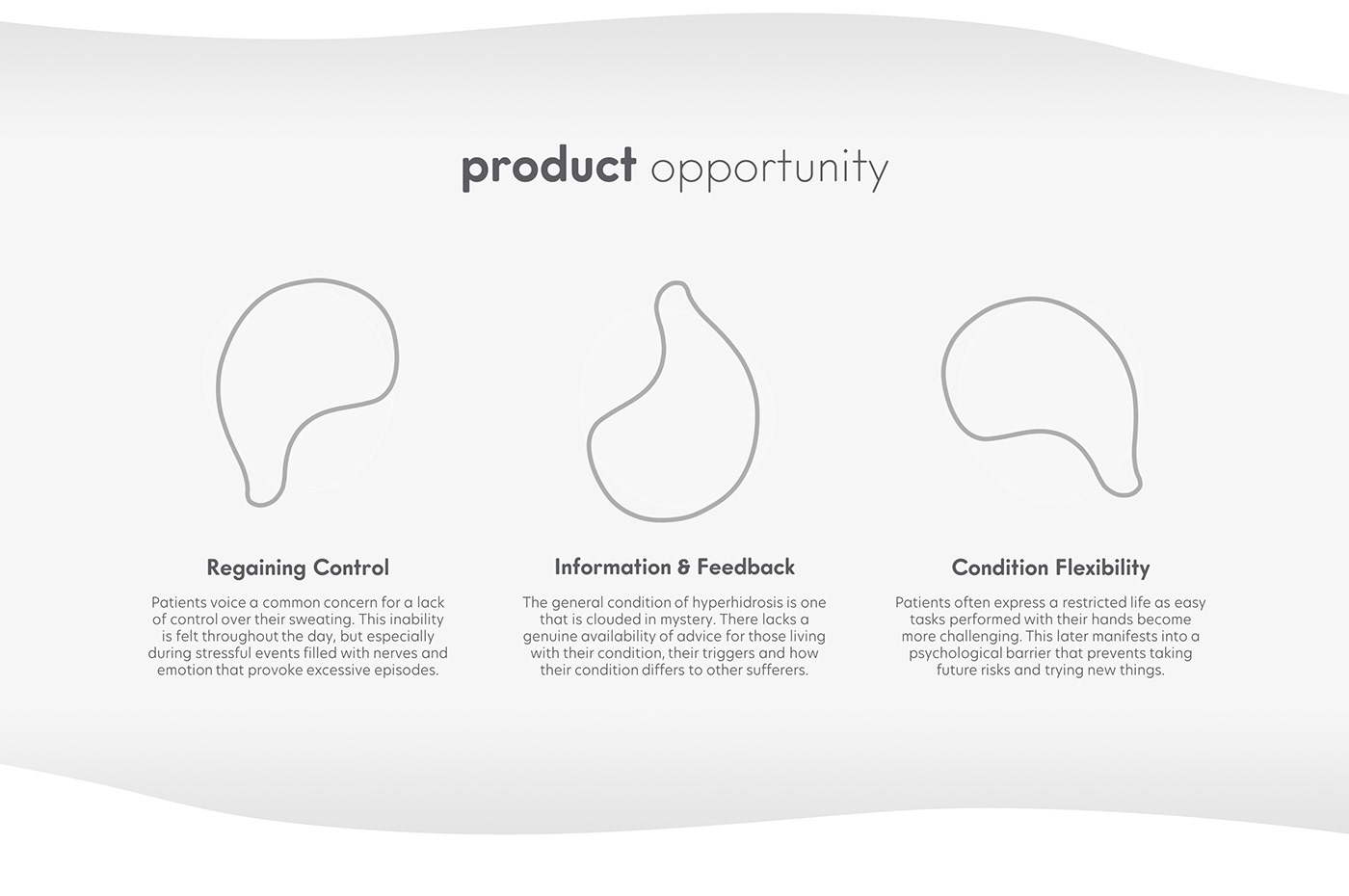
palm.
Problem Definition
Palmar hyperhidrosis is a dermatological condition characterised by chronic excessive sweating from the hands. A dermatological skin condition that affects 1% of the global population, equating to approximately 70 million people worldwide. A largely unheard-of, a profoundly stigmatising diagnosis that has effects on an individual's physical tactility, psychological well-being and overall quality of life.
Product Overview
The 'Palm' iontophoresis device allows patients to control their palmar perspiration through iontophoretic therapy, a process of passing a minor electrical current through the hand to block overactive sweat glands. 'Palm' harnesses the use of galvanic skin responses to measure sweat levels throughout their iontophoretic journey. This provides an insight into the emotionally driven sweat triggers that gives patients an opportunity for methodical perspiration intervention. The 'Palm' device ultimately aims to empower patients to recapture control of their stigmatising condition, eroding physical and mental barriers by introducing a positive lifestyle through body appreciation.

The research phase was underpinned by an uninterrupted stream of dialogue with numerous palmar hyperhidrosis sufferers, vocalising the effects of their condition on daily life, the implications on their psychological well-being and identifying personal workarounds to unmet needs. Three patients subsequently committed their long-term participation to provide short feedback loops on feasible routes to concept proposals and their invaluable opinion on implementing solutions on behalf of those suffering in silence.

Tactile Ramifications
Excessive hand sweat present significant problems throughout daily work-related and leisure activities, often characterised as a lack of grip and applied tactility when performing even the most mundane of tasks. This problem has recently exacerbated due to the increasing reliance on touch technologies, that fail to register user interaction when their fingers are wet.
Socially Stigmatising Ramifications
Palmar hyperhidrosis sufferers often express a reluctance to engage in physical interaction such as shaking hands with others to prevent them noticing their excessive perspiration. Often perceived to be a heightened sense of nervousness, suffers erect a self-imposed physical barrier of engagement. This can lead to a feeling of a restricted life during social situations, culminating in a the feeling of a general loss of control.
Psychological Ramifications
The persistence presence of perspiration on patient's hands has induced an overwhelming sense of embarrassment, a period of self-reflection that evokes negative emotions, in fear of someone noticing. The outlook can elapse the entirety of daily lives for sufferers, which can lead to social anxiety and depression when not treated or addressed.

Defined Brief
A project-specific design brief was developed to address several reoccurring sweat-related struggles and frustrations identified from patient accounts of their daily lives. This provided a clear distinction between unique problem areas to address, whilst simultaneously creating a platform for which purposeful conceptualisation can transpire.


A thought-provoking design question represented each problem area of the project-specific design brief, giving rise to many impactful solution proposals. These preliminary sketches were subsequently pitched to patient users, allowing for an invaluable early stage input of their overall response to concepts. Several peaked considerable excitement and were selected for further consideration.





Throughout the ideation phase of the project, heightened emphasis was placed on developing a product that had a profoundly positive impact on palmar hyperhidrosis patients. This exploratory process ultimately concluded in the lack of control of their sweating, portraying a need to target this need directly. The conclusion was to redesign an iontophoresis device, addressing many shortcomings of current market options.

Form Exploration
The construction of low-fidelity prototypes offered a means for identifying an overall form that would feasibly achieve palmar coverage for functional iontophoretic treatment. Various unique geometries were explored to promote a sense of comfort and flexibility during treatment.

Prototype Development
A number of electrical configurations were built to determine the best approach to electrode connection. These were subsequently tested to ensure an adequate current measure was achieved to deliver a successful iontophoretic session.









Final Design
The Palm device offers a discreet means of iontophoretic therapy. It harnesses the use of galvanic skin responses to determine levels of palmar perspiration, giving the user a way of monitoring levels of sweat reduction.







The Palm App
The Palm accompanying mobile application provides access to the user's incremental sweating metrics. A platform that encourages proactive interaction through striding towards sweat-related goals, keeping up to date with the user's therapy schedule.




Thank you for your time :)






